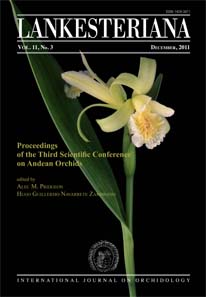Botanic gardens, education, and orchid conservation strategies: the need for a coordinated approach
DOI:
https://doi.org/10.15517/lank.v11i3.18285Keywords:
orchids, conservation, ex situ collections, recovery, educationAbstract
The call for orchid conservation has been heard worldwide by scientists, horticulture professionals, commercial propagators, and passionate private enthusiasts, all with different opinions and approaches on how to tackle this worldwide problem. The news has been dire with the prospects of global warming, habitat destruction, displacement of natives by aggressive exotics, unsustainable plant predation/harvesting, and impotent efforts to enforce legal protections. Considerable thought and effort have gone into specific strategies for orchid conservation, including habitat protection, buying and preserving ‘hot spots’, and the trends toward creating horticultural reserves, both native (Lankester Gardens, Ecominga Foundation, Ecuagenera reserves) and ex situ (orchid gardens in Hawaii, collections under glass, etc.) Tactics such as seed-banking, DNA technology, ex situ propagation efforts, and eventual reintroductions are inherently dependent on the resources and holdings of botanic gardens and responsible commercial growers. It is such horticultural work that has saved genera such as Franklinia, Torreya, and Wollemia as well as orchid species such as Paphiopedilum vietnamense, Epidendrum ilense, and Angraecum longicalcar from complete extinction. Botanic gardens, while united by certain organizations such as the American Public Garden Association (APGA) and Botanic Garden Conservation International (BGCI), need greater cooperation and coordination of their plant conservation efforts. In addition, it is critical for botanic gardens to engage the scientific community (and vice versa), especially those who can best assess which species are the most endangered. If collections are to be used optimally, the scientific and horticultural communities must become more aware of each other’s assets and priorities. At the first International Orchid Conservation Congress (IOCC), four resolutions were adopted from the Global Strategy for Plant Conservation (GSPC): 1) 90% of all threatened orchids should be secure in ex situ collections; 2) 50% should be in active recovery programs; 3) no orchids should be threatened by unsustainable harvesting; and 4) every child should be aware of plant diversity (including orchids) by 2010. How do we assess whether progress has been made toward these admirable goals without a unifying entity to compile the progress, information, and successes? With so much effort going on in so many separate places, such an entity is sorely needed. In addition, the plant conservation community needs more coordination with the efforts of the animal conservation community. It is the goal of many botanic gardens and a specific goal of the Smithsonian Institution to promote the diffusion of knowledge and understanding. To this end, goal # 4 above is a particular priority. While reaching the goal of 100% awareness of plant diversity by 2010 is not possible, we have undertaken various educational initiatives aimed at promoting conservation awareness in our visitors, especially young people. For educators, it is imperative to instill these values at an early age.
Downloads
Downloads
Published
How to Cite
Issue
Section
License
According to the Open Access policy promoted by the University of Costa Rica, all the papers published by Lankesteriana are licensed under the Creative Commons copyright and can be downloaded free of charge. The journal holds copyright and publishing rights under the CC BY-NC-ND 3.0 CR license.
Before the publication of the materials submitted by the author(s) in LANKESTERIANA, the author(s) hereby assign all rights in the article to the Lankester Botanical Garden.





